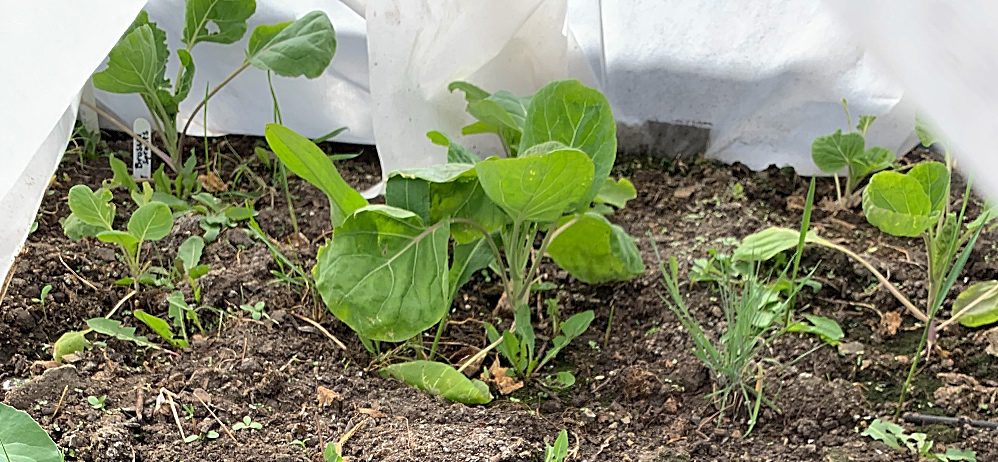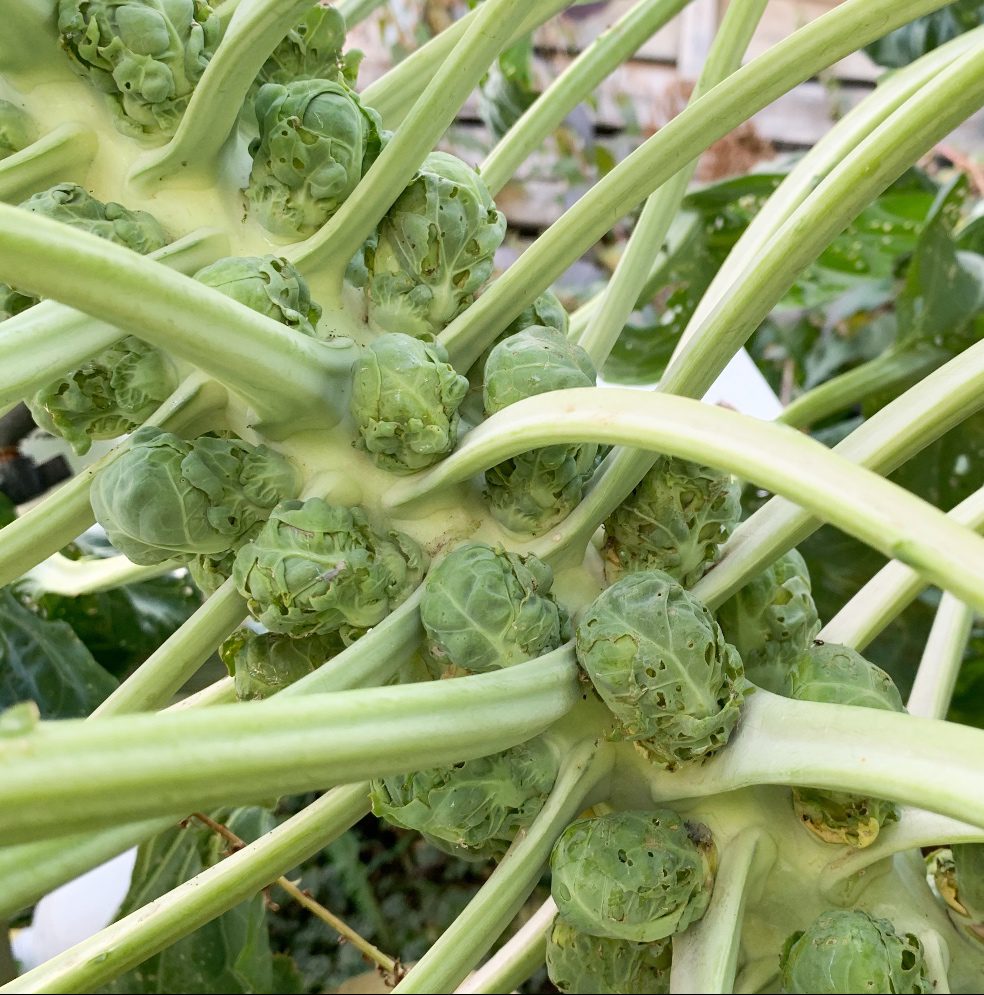Brussel sprouts can be tricky to grow in a cold climate with a short growing season like Zone 3. They take a long time, are prone to bug pressure, and take up a lot of space. However, the taste of an organic, homegrown brussel sprout roasted to perfection makes it worth it!
It’s taken me four tries to finally grow Brussels sprouts worth eating, and now I will share with you how I grow them from seed. My advice will work best for those who garden in Zones 2, 3, and 4, but the bug pressure advice should work for any gardener in any zone.
Brussels sprouts are a tasty and nutritious vegetable to grow, but various insects find them just as appetizing. Pests like aphids, caterpillars, and thrips can quickly damage Brussels sprouts if left unchecked. Fortunately, there are effective organic and natural ways to deter bugs and keep your Brussels sprouts thriving.
Common Brussels Sprout Pests
Some of the most troublesome bugs that attack Brussels sprouts include
-
Aphids – These tiny sap-sucking insects cluster on leaves and stunt plant growth They secrete sticky honeydew that can lead to sooty mold Frequency of occurrences 4
-
Caterpillars – Cabbage loopers, diamondback moths, and imported cabbage worms chew holes in leaves and burrow into sprout heads. Frequency of occurrences: 2
-
Thrips – Tiny flying insects that cause distorted growth, silvered spots, and spread disease. Frequency of occurrences: 2
-
Flea beetles – Jumping beetles that chew tiny holes in foliage called shotholes. Frequency of occurrences: 1
-
Cabbage maggots – Larvae of fly species that bore into root crops and stems. Frequency of occurrences: 1
-
Slugs/snails – Leave large holes in leaves and can devour seedlings overnight. Frequency of occurrences: 1
-
Whiteflies – Like aphids, these sap-sucking insects secrete sticky honeydew and can spread disease. Frequency of occurrences: 1
Organic Ways to Get Rid of Brussels Sprout Bugs
Here are some effective organic remedies and prevention methods to eliminate bugs on Brussels sprouts:
-
Row covers – Lightweight fabric barriers keep out most flying and crawling pests. Use insect netting with a tight weave.
-
Water spray – Strong blasts from the hose knock off aphids, thrips, whiteflies, and caterpillars.
-
Neem oil – Derived from the neem tree, this oil smothers soft-bodied insects. It’s non-toxic to humans and plants.
-
Insecticidal soap – Potassium salts in soap disrupt soft pest bodies but are gentle on plants.
-
Diatomaceous earth – Dust this powder on plants as a physical insecticide that cuts into exoskeletons and kills pests.
-
Bacillus thuringiensis (Bt) – This natural bacteria controls caterpillars when ingested. Brands like Dipel and Thuricide target worms.
-
Pyrethrins – Botanical extracts from chrysanthemums are approved for organic use to kill insects.
-
Beneficial insects – Release or attract predatory bugs like lady beetles, lacewings, and parasitic wasps to eat pests.
-
Sticky traps – Yellow boards or glossy paint catch winged pests like whiteflies, aphids, and fungus gnats.
-
Slug traps – Beer-baited traps attract and drown slugs and snails that come to feed at night.
-
Copper tape – Sharp metal deters slugs and snails when wrapped around raised beds or pot rims.
-
Egg shells – Crushed eggshells create a rough, jagged barrier that repels crawling pests.
Preventing Infestations Organically
-
Rotate Brussels sprout planting location each year to disrupt pest life cycles.
-
Time plantings for spring/fall when pests are less active. Avoid heat of summer.
-
Interplant with pest-repelling plants like basil, garlic, onions, and marigolds.
-
Use a cover crop like clover to boost beneficial nematodes that prey on pests.
-
Remove and destroy heavily infested plants to prevent spread.
-
Handpick large pests like cabbage worms and loopers. Check under leaves.
-
Use a strong water spray to dislodge bugs and rinse off honeydew buildup.
-
Avoid excess fertilization that creates rapid, tender growth that attracts pests.
-
Monitor for eggs and small infestations. Take action before pests multiply.
-
Clean up crop debris after harvest to eliminate pest habitat and food sources.
When to Use Chemical Products
For severe infestations, certain synthetic insecticides are approved for organic gardening as a last resort. Always follow label precautions. Options include:
-
Spinosad – Derived from a soil microbe; targets caterpillars, beetles, flies, and thrips.
-
Azadirachtin – Extracted from neem seeds; insect growth regulator that deters feeding.
-
Pyrethrins – Can be combined with other organic oils for quick knockdown of insects.
-
Insecticidal soap – Higher concentrations required than for organic use.
-
Horticultural oils – Smother soft-bodied insects on contact while safe for plants.
-
Bacillus thuringiensis (Bt) – Available in stronger formulations than organic varieties.
-
Beauveria bassiana – Fungal pathogen that infects and kills many pest species.
Protecting Brussels sprouts from insects the natural way allows you to grow chemical-free, nutritious produce. Combine preventive measures with prompt organic treatment to keep your plants bug-free.

Are Brussels sprouts easy to grow from seed?
Yes, but in a short growing season, you’ve got to get the timing right. The bulk of my garden typically gets planted around the May Long weekend in Canada (sometime around May 20th), but Brussels sprouts need to be both started from seed and put outside much sooner than that.
The Brussels sprout seedlings below were started ten weeks before our last frost date–around the first week of March.

Since Brussels sprouts love and can handle the cold, I put them out in my raised beds under frost cloth and hoops around the beginning to middle of April. This step is the key to my Brussels sprout growing success.
The Brussels sprouts in these photos thrived in the cooler spring weather and were not stunted in size by staying in a seed starting pack for a longer time. The frost cloth kept them warm enough, but it was okay if there was a killing frost overnight because Brussels sprouts can handle colder temperatures.
It’s key to remember this fact in the fall.
When it’s the beginning of September and the first frost comes, don’t worry about covering your Brussels sprouts–they’ll be totally fine. In fact, if your Brussels sprouts are still on the small side, keep them in the ground until the temperature drops to around -10°C/14°F or lower. When writing this post, it was the beginning of October and my plants (except the one I pulled in the video) were still in the ground.

What insects eat Brussels sprouts? (And what do I do about it?)
One of the things that make Brussel sprouts so difficult to grow is that so many bugs like to eat them! Flea beetles, slugs, aphids, and more all love to get into them. It’s also frustrating because of the way Brussels sprouts leaves overlap each other. Once the bugs get in they can’t really get out, and it’s very difficult to get rid of them.
Sadly, the best way to “get rid of bugs” from Brussels sprouts is to prevent them in the first place. To do that, I keep the frost cloth over the plants as long as possible, as they also keep out most of the bugs. You can replace the cloth with actual bug cloth if you wish once the risk of frost is over.
The only downside of preventing bugs this way is that you need to make the hoops really tall. Mine were only about 2-3 feet tall, which was not nearly enough. Now I make them at least 4 feet tall, so I can keep them on through most of the bad bug pressure.
Finally, if aphids are the bug plaguing your vegetables, you can buy a colony of ladybugs from your local garden centre. Lady bugs eat aphids, so they’re a great natural pest control.

How To Organically Get Rid of Aphids On Brussels Sprouts – Kid and Pet Friendly Insecticide
FAQ
How do you get rid of bugs on Brussels sprouts?
Food grade diatomaceous earth with a duster. Very often the duster comes. with it. Get under the leaves and open up the top leaves a little. They like hiding there… The brassica aphids are ugly little bugggers. Spray them off really well before you decide to harvest. I’ve heard some.
How to protect your Brussels sprouts?
They are best grown under fine-mesh netting to protect them from insects and pigeons. If you have club root disease in your soil, start Brussels sprouts off indoors so the plants have a well-developed root system before they’re transplanted into the ground.
What’s eating holes in my Brussels sprouts?
It’s almost certainly gonna be a cabbage looper or cabbageworm (the latter is a caterpillar as well)…in storebought produce, you’d be most likely to find them in either broccoli, cauliflower, or kale (lots of nooks & crannies to hide in). You must be getting some very fresh (and very minimally sprayed!)
